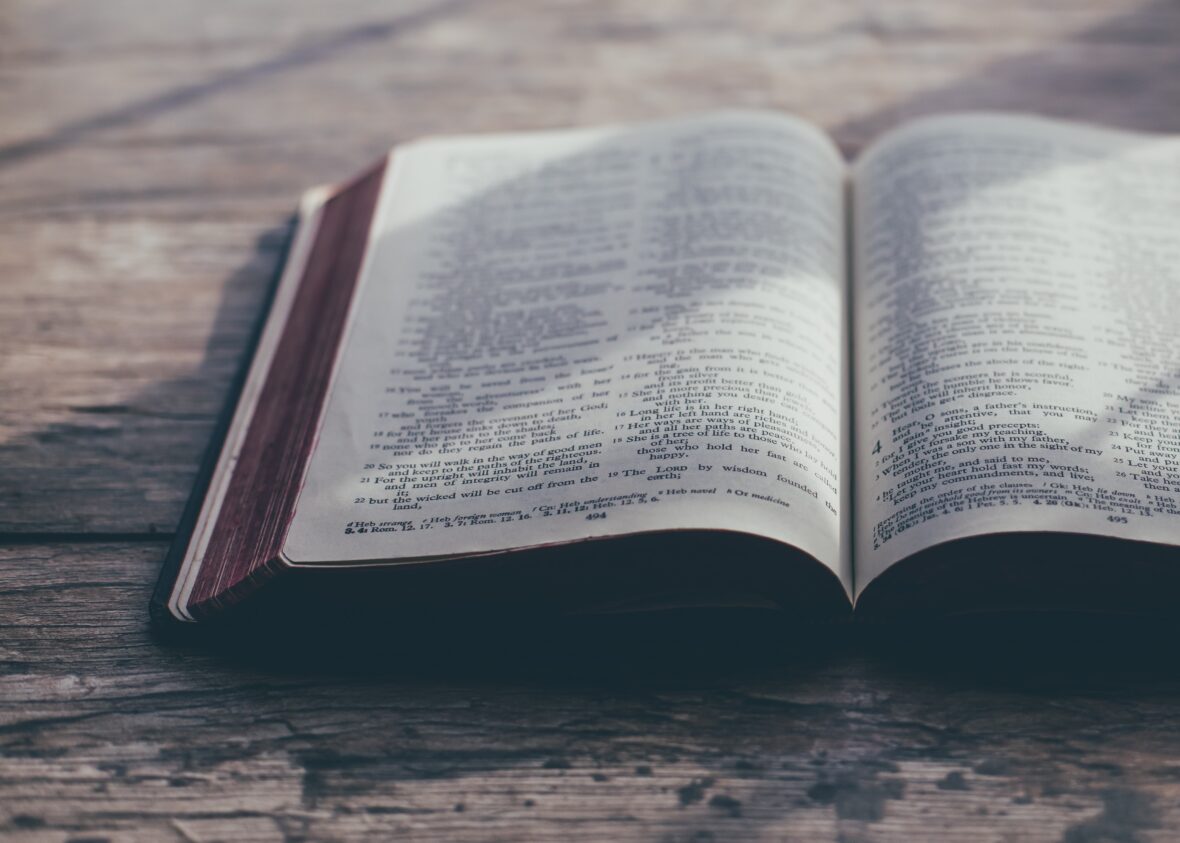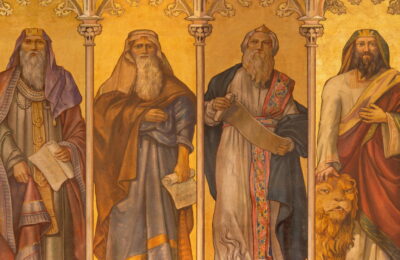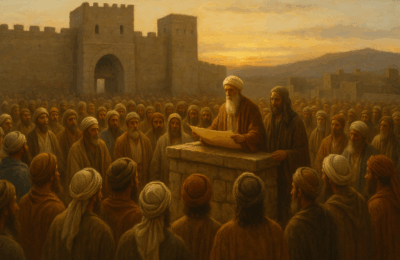Home | Bible Resources | Pentateuch (or the Law)
Leviticus: Walking with a Holy God
Introduction
What happens after redemption?
Exodus ends in glory. The tabernacle is completed, the cloud descends, and the holy presence of God fills the camp. But then comes Leviticus — and the tone shifts. The question is no longer how will God save us? but how can we now live near Him without being consumed?
That’s the burden of Leviticus: a holy God has chosen to dwell among a sinful people — and that requires holiness.
Leviticus is often skipped by modern readers, mistaken for irrelevant rituals or outdated regulations. But for those willing to linger, this book becomes a theological treasure chest. It reveals God’s character — His purity, mercy, justice, and compassion. It outlines the terms of covenant life and teaches what it means to be set apart. It shapes a worldview where sin is serious, sacrifice is costly, and worship is not casual.
At the center of it all is blood. Blood on the altar. Blood sprinkled before the veil. Blood on the Day of Atonement. This is not primitive superstition — it is divine pedagogy. It teaches that the life of the flesh is in the blood, and without the shedding of blood there is no forgiveness (Leviticus 17:11; Hebrews 9:22).
And ultimately, all of it points forward — to a better priest, a better sacrifice, and a better covenant.
Jesus Christ is the fulfillment of every burnt offering, every purification rite, every sabbatical rest, and every priestly intercession. Leviticus may begin with a call from the Tent of Meeting, but it ends by preparing our hearts for a veil torn open by grace.
If Exodus shows us how God rescues, Leviticus shows us how He refines.
If Exodus is about deliverance, Leviticus is about discipleship.
This is a book for those who want to walk with God — not at a distance, but in the light of His holiness, under the shadow of His mercy.
1. Title, Author, and Date
Leviticus is the third book of the Pentateuch and the theological center of the Torah. It details how a redeemed people are to live in covenant fellowship with a holy God through sacrifices, priestly mediation, and moral purity.
- Hebrew Title: וַיִּקְרָא (Vayikra) — “And He Called” Taken from the book’s opening phrase, emphasizing God’s call to Moses from the Tent of Meeting.
- Greek Title: Λευιτικόν (Leuitikon) — “Pertaining to the Levites” Reflecting the book’s priestly and sacrificial focus, though most laws apply to all Israel, not just the tribe of Levi.
- Authorship: Traditionally and unanimously attributed to Moses Internal claims (e.g., Leviticus 1:1; 4:1; 6:1) and consistent external tradition support Mosaic authorship.
- Date: c. 1445–1444 BC, during the Israelites’ encampment at Mount Sinai following the Exodus (cf. Exodus 40:17; Numbers 1:1).
- Setting: Camped at Mount Sinai; the tabernacle has been completed (Exodus 40), and God now instructs how He will dwell with Israel through holiness and atonement.
Covenantal Role:
Leviticus reveals how the Mosaic Covenant functions in daily life. It legislates holiness, sacrifice, and priestly mediation as the terms of maintaining fellowship between God and His redeemed nation.
📊 Book Stats Sidebar
- Chapters: 27
- Verses: 859
- Approx. Word Count: 24,500 (NASB)
2. Purpose and Themes
Leviticus instructs Israel how to live in the presence of a holy God, emphasizing the need for atonement, purification, and holiness in every area of life—from sacrifices to sexual ethics to sabbatical rhythms.
Central Purpose: To instruct Israel in how to approach, worship, and walk with a holy God in covenant relationship.
Major Doctrinal Themes:
- Holiness of God — “Be holy, for I am holy” (Lev 11:44–45)
- Atonement through substitutionary sacrifice
- Priestly mediation and access to God
- Clean and unclean distinctions (ritual and moral)
- Obedience as covenant faithfulness
- Sabbath and sacred time
- Blessings and curses for covenant loyalty or rebellion (Lev 26)
Structural Features:
- Chiastic structure around the Day of Atonement (Leviticus 16)
- Repetitive, ritualistic language to emphasize holiness
- Legal case laws, narrative interjections, and cultic instruction
- Covenantal formula: “I will be your God, and you shall be My people” (Lev 26:12)
3. Outline
The book of Leviticus unfolds in three major sections: approaching God through sacrifice (ch. 1–10), maintaining purity in daily life (ch. 11–16), and walking in holiness through obedience (ch. 17–27).
I. The Way to God: Sacrifice and Priestly Ministry (1:1–10:20)
A. Laws of Sacrifice (1:1–7:38)
- Burnt offering (1)
- Grain offering (2)
- Peace offering (3)
- Sin offering (4:1–5:13)
- Guilt offering (5:14–6:7)
- Priestly responsibilities (6:8–7:38)
B. Ordination of the Priests (8:1–9:24)
- Consecration of Aaron and sons (8)
- Inaugural offerings and God’s glory (9)
C. The Sin of Nadab and Abihu (10:1–20)
- Unauthorized fire and divine judgment (10:1–7)
- Priestly holiness and instruction (10:8–20)
II. The Need for Cleansing: Purity Laws and the Day of Atonement (11:1–16:34)
A. Laws of Ritual Purity (11:1–15:33)
- Clean and unclean animals (11)
- Purification after childbirth (12)
- Leprosy and skin diseases (13–14)
- Bodily discharges (15)
B. The Day of Atonement (16:1–34)
- Preparation and procedures for the High Priest
- The scapegoat and national atonement
III. The Walk with God: Holiness in Daily Life (17:1–27:34)
A. The Holiness Code (17:1–22:33)
- Proper worship and blood (17)
- Sexual morality (18)
- Social and ethical holiness (19)
- Punishments and boundaries (20)
- Priestly holiness (21–22)
B. Sacred Time and Worship (23:1–25:55)
- Feasts and appointed times (23)
- Tabernacle and sacred items (24)
- The Sabbatical and Jubilee years (25)
C. Covenant Blessings and Warnings (26:1–46)
- Blessings for obedience
- Curses for rebellion
- Promise of restoration
D. Vows and Dedications (27:1–34)
- Voluntary vows
- Redemption laws
- Final tabernacle taxation laws
Canonical Flow: Leviticus functions as a priestly manual that deepens the covenantal relationship established at Sinai. It moves the story from deliverance to sanctification, showing how a redeemed people must live in holiness before a holy God. The book anchors Israel’s identity in worship, sacrifice, and purity, pointing forward to the ultimate High Priest and perfect sacrifice in Christ.
4. Key Themes and Theological Contributions
Leviticus provides the theological foundation for understanding substitutionary atonement, the priesthood of Christ, and the holiness of God’s people. It draws a direct line from the altar of burnt offering to the cross of Calvary.
Theological Contributions:
- Holiness as a way of life — God’s character defines the moral and ritual boundaries for His people.
- Substitutionary Atonement — The offerings vividly portray sin’s penalty and God’s mercy through substitution (Hebrews 9:22).
- Priesthood and Mediation — Human access to God must come through a mediator—a theme fulfilled in Christ (1 Tim 2:5).
- Sacred Space and Time — God’s presence defines space (Tabernacle) and shapes time (feasts, Sabbaths).
- Typology of Christ — Every offering and priestly role points forward to Jesus, our final High Priest and Lamb.
📌 Memory Verse:
Leviticus 17:11 (LSB) — “For the life of the flesh is in the blood, and I have given it to you on the altar to make atonement for your souls; for it is the blood by reason of the life that makes atonement.”
⚔️ Major Rebellions / Turning Points:
- Nadab and Abihu’s Strange Fire (Lev 10) — Presumptuous worship provokes holy judgment, emphasizing God’s holiness.
- Violation of Holiness Laws (Lev 18–20) — Sexual immorality and idolatrous practices threaten Israel’s covenant identity.
- Covenant Curses Foretold (Lev 26) — A prophetic preview of Israel’s future disobedience, exile, and ultimate restoration.
5. Christ in Leviticus
Leviticus is a shadow-casting book — filled with types, patterns, and images that find their fulfillment in Jesus Christ, the sinless Lamb and eternal High Priest.
Christological Fulfillments:
- Jesus as the Fulfillment of Every Offering • Burnt Offering → His total consecration (Eph 5:2) • Grain Offering → His sinless perfection (John 6:35) • Peace Offering → Our reconciliation in Him (Rom 5:1) • Sin/Guilt Offerings → His substitutionary death (Heb 10:10)
- Jesus as Our Great High Priest • Fulfills the priestly role forever (Heb 4:14–16; 7:25)
- Jesus and the Day of Atonement • Enters the true Holy of Holies with His own blood (Heb 9:11–14) • The scapegoat bearing sin outside the camp (Heb 13:12)
🔗 Suggested Cross-Reference Chart: Leviticus → Hebrews
| Levitical Element | Fulfillment in Christ | Reference |
|---|---|---|
| High Priest | Jesus, eternal High Priest | Heb 4:14 |
| Sacrifices | Christ’s once-for-all offering | Heb 10:10 |
| Tabernacle | Heavenly tabernacle | Heb 9:24 |
| Blood | Atoning blood of Christ | Heb 9:22 |
| Day of Atonement | Final atonement at the cross | Heb 9:12 |
6. Historical and Literary Notes
Leviticus fits within the ANE context of temple worship and ritual purity but stands apart in its theocentric, covenantal theology rooted in divine holiness and grace.
Genre:
- Legal instruction, ritual law, priestly code
- Covenant renewal and instruction narrative
ANE Context:
- Unlike pagan systems where rituals manipulated gods, Leviticus reveals a holy, moral God who graciously provides atonement and access on His terms.
👤 Key Characters:
- Moses – Covenant mediator and prophet, receiving divine instruction
- Aaron – Israel’s first high priest, representative of the priesthood
- Nadab and Abihu – Aaron’s sons judged for unauthorized worship
- The High Priest (archetype) – Typifies Christ’s priestly office
- YHWH – The holy, covenant-making God dwelling among His people
7. Applications for Today
Though we are no longer under the Mosaic Law, Leviticus forms our foundation for understanding holiness, worship, and the cost of atonement — all of which are fulfilled and reoriented in Christ.
Discipleship Formation:
- Live out holiness in every sphere — not legalism, but covenant loyalty.
- Worship must be reverent, not casual — God’s presence is sacred.
- Understand the cost of grace — sin always requires blood (Rom 6:23).
- Recognize God’s rhythm — Sabbath, rest, and remembrance are still formative.
Worldview and Ethics:
- God defines moral purity, not culture (cf. Lev 18).
- We approach God on His terms, not through human innovation.
- Sacredness of life and blood shapes Christian ethics on life, death, and justice.
8. Shoe Leather Discipleship Tie-In
This book shows us that walking with a holy God requires more than occasional reverence — it demands a life marked by consecration, gratitude for atonement, and obedience rooted in love. Leviticus trains our hearts to see the weight of sin and the wonder of grace. It teaches us to approach the Lord in holiness, knowing that our Great High Priest has opened the way.
So put on your gospel shoes. The altar is behind us. The Holy One walks with us.







